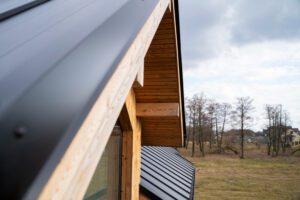Building a house is one of the most exciting projects in life. For many, it represents the realization of a long-awaited dream — a place designed with care, reflecting personal needs and lifestyle. Yet, while new construction brings joy and pride, it also carries hidden risks. The period between laying the foundation and moving in is one of the most vulnerable times for your property, with potential threats from thieves, natural forces, and accidents. Understanding how to safeguard your unfinished home is essential to avoid major financial losses and emotional stress. According to construction safety researcher Dr. Michael Anderson from the University of Manchester, “the construction phase is the single most overlooked period in residential security planning.” His remark highlights the urgent need for awareness and protection before it’s too late.
Hidden dangers on construction sites
Across Europe, including Lithuania, the number of newly built individual and multi-apartment homes continues to grow rapidly. However, with this boom comes a sharp increase in construction-related incidents — from thefts and vandalism to damage caused by storms, fires, and carelessness. Even an unfinished house is already valuable property, often holding tens of thousands of euros in materials and equipment. In 2024, the European Construction Safety Council reported that construction-site theft accounted for nearly €1.5 billion in annual losses across EU member states, emphasizing that small residential projects are particularly vulnerable.
Thieves are particularly drawn to construction sites because they are typically unmonitored at night and lack installed security systems. Missing windows, unlocked doors, and the absence of lighting make these locations easy targets. Criminals often steal expensive building materials, wiring, plumbing equipment, tools, and even fuel from construction machinery. In some cases, they cause additional damage — breaking windows or doors while gaining entry.
Beyond theft, natural forces such as strong winds, storms, or heavy rainfall can also cause significant destruction. There are documented cases where an uncompleted house lost its freshly installed roof to a sudden storm, or where fire damaged heating and ventilation systems worth thousands of euros. These incidents are more common than people imagine, and the resulting repair costs can delay construction for months.
Why construction insurance is essential
One of the most effective ways to protect yourself from these risks is to invest in construction and liability insurance. Many homeowners mistakenly believe that insurance is only needed once the house is completed and registered. In reality, insurance should be arranged as soon as construction begins. This ensures that all materials, structures, and ongoing works are covered from day one. “Insurance during construction is not a luxury — it’s a necessity,” says Sarah Bennett, a risk management specialist from the European Institute of Property Safety. “We have seen countless cases where early insurance coverage saved families from catastrophic losses.”
Construction insurance typically includes protection for materials that are or will become part of the building — from flooring and insulation to heating systems and tiles. It also covers damage caused by theft, fire, storms, or vandalism. In the event of an incident, the insurance company compensates the homeowner for the loss, often saving tens of thousands of euros. Statistics from the Insurance Europe Association show that insured construction sites experience 60% fewer financial losses compared to uninsured ones.
For instance, there have been real cases where homeowners received compensation of €12,000 after burglars damaged a window and stole heating equipment, or €24,000 after a fire destroyed a newly installed ventilation system. Without insurance, such losses could have been devastating. In addition to property coverage, liability insurance protects against potential damage caused to third parties — for example, if construction debris injures a passerby or damages a neighbor’s fence. These cases can lead to costly lawsuits if not properly insured.
Who should handle the insurance
Responsibility for arranging construction insurance depends on the type of project. For large-scale developments such as apartment buildings or commercial properties, the contractor or construction company usually handles the insurance process. However, for private houses or smaller projects, the homeowner must take initiative. Real estate law lecturer Prof. Elena Garcia from the University of Barcelona explains: “When it comes to private property, the owner bears ultimate responsibility for ensuring that construction and liability insurance are in place. This is a legal and practical safeguard.”
Even if construction is already underway, it’s not too late to obtain insurance. Many insurers can provide coverage for ongoing projects, protecting against future risks. Furthermore, construction insurance is a mandatory requirement for registering the completed building in the national property registry. This means that skipping it not only puts your investment at risk but also delays legal formalities.
Smart ways to reduce risks
While insurance offers strong financial protection, combining it with smart security practices greatly enhances safety. There are several proven measures that homeowners and contractors can take to deter theft and minimize risks:
- Secure the site daily. At the end of each workday, lock all entry points and ensure that windows are fully closed. If possible, install temporary doors and barriers to limit access.
- Install an alarm system. Even a simple security alarm linked to a monitoring service can drastically reduce the likelihood of theft. Many thieves are deterred by visible alarm signage or cameras.
- Use proper lighting. Motion-activated lights around the site can discourage intruders and make suspicious movement easier to detect.
- Store materials safely. Avoid leaving valuable materials or equipment outside overnight. Keep tools and machinery in locked containers or transport them off-site.
- Monitor weather conditions. Before storms or strong winds, reinforce scaffolding, cover exposed materials, and secure roofs or panels that could be blown away.
Construction safety consultant Dr. Robert Hughes, who has over 20 years of experience in risk prevention across Europe, emphasizes that “security is not only about technology — it’s about discipline. Daily inspection routines, documented checklists, and team awareness prevent more damage than any alarm system alone.” His advice underscores the importance of consistent management practices in addition to physical security.
It’s also crucial to maintain regular communication between the homeowner, builder, and insurance provider. Inform your insurer of any major changes to the construction plan or materials used — this ensures your coverage remains valid and accurate.
Common mistakes to avoid
Homeowners often make avoidable mistakes that lead to unnecessary losses or insurance complications. Among the most common are:
- Delaying insurance coverage until construction is almost finished. Protection should begin as soon as building materials arrive on site.
- Assuming contractors’ insurance covers everything. Builders’ policies may only cover their liability, not the homeowner’s property.
- Neglecting security. Believing that theft “won’t happen here” is a costly assumption. Construction sites are prime targets precisely because of that mindset.
- Improper storage of materials. Leaving expensive items exposed increases both theft risk and weather damage.
- Ignoring small incidents. Even minor damage should be reported and repaired promptly before it worsens or affects insurance validity.
By avoiding these pitfalls, homeowners can save both time and money, ensuring that their dream home progresses smoothly and securely toward completion.
The value of proactive protection
Building a house requires not only financial investment but also foresight. Insurance and preventive security measures may seem like additional costs at first, but they are in fact essential tools for safeguarding your investment. Every bag of cement, every pipe, and every tile adds to the total value of your unfinished home — and deserves protection from day one.
According to a 2023 study by the American Home Builders Association, homes with documented construction-stage insurance and security protocols are 45% less likely to experience project delays. This data reinforces the idea that preparation is not merely caution — it is sound financial strategy. Proactive planning gives peace of mind. It allows homeowners to focus on design and progress rather than worrying about what could go wrong overnight. Moreover, ensuring proper documentation and coverage demonstrates responsibility — a key factor that lenders, contractors, and authorities respect.
Summary
Building a new home is a major milestone, but it comes with risks that should not be underestimated. Theft, fire, and natural forces can cause unexpected setbacks even before the house is complete. The best way to avoid these losses is through timely construction and liability insurance, combined with practical on-site security measures such as alarms, lighting, and safe storage. Avoiding common mistakes like delayed coverage or poor organization can prevent significant financial stress. In the end, protecting your future home before moving in is not just a precaution — it’s a smart investment in your safety, peace of mind, and the long-term value of your property. As Professor Bennett concludes, “security begins the moment you start building — not the day you move in.”







